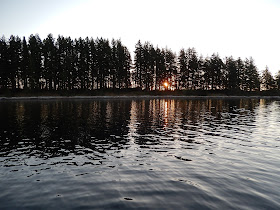 Not far from our float cabin home, logging roads reach deep into the back country. These paths, carved out of the deep forest, allow us to explore on foot and by quad. The extensive network of trails are also filled with logging history if you know where to look.
Not far from our float cabin home, logging roads reach deep into the back country. These paths, carved out of the deep forest, allow us to explore on foot and by quad. The extensive network of trails are also filled with logging history if you know where to look.  This week, Wayne and I took our quads up Heather Main (a main logging road) from Powell Lake near the Chippewa Bay logging dock.
This week, Wayne and I took our quads up Heather Main (a main logging road) from Powell Lake near the Chippewa Bay logging dock. There are two large pieces of equipment abandoned along this well used road. When machines were no longer operational, it was often easier to just leave them in place. Now it's like riding through a living museum.
There are two large pieces of equipment abandoned along this well used road. When machines were no longer operational, it was often easier to just leave them in place. Now it's like riding through a living museum.This trip, we went as far as the first shovel built by Bucyrus-Erie of Milwaukee, Wisconsin.

 I invite you to visit a website I enjoy, www.vanishinghistory.ca. Check out their post with pictures and a video about the shovels up on Heather Main. The people behind this website are long-time Powell Riverites including Rob Tremblay, Pat Haist, and Troy McDonnell. These guys know the stories behind these pieces of local history. -- Margy
I invite you to visit a website I enjoy, www.vanishinghistory.ca. Check out their post with pictures and a video about the shovels up on Heather Main. The people behind this website are long-time Powell Riverites including Rob Tremblay, Pat Haist, and Troy McDonnell. These guys know the stories behind these pieces of local history. -- Margy




























